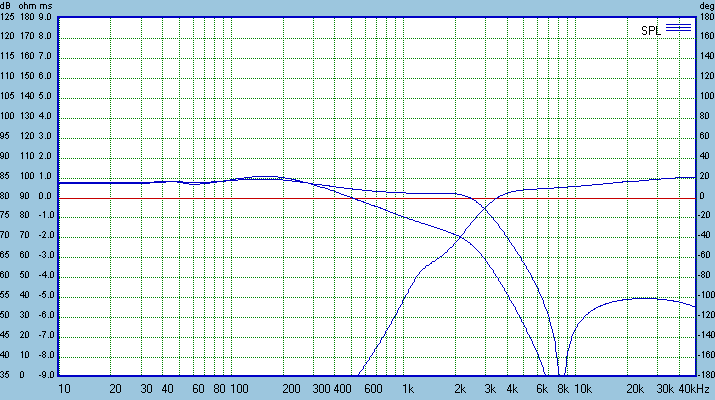Notes
The following brief comments come to mind, some of which may be redundant due to my not reading every post here or because it is information already known to you.
1) The larger the radiating surface area, the further behind the driver array will be the acoustic image. The use of horned drivers here is contraindicated unless your listening space is arena sized with the drivers far removed from the audience
2) Always insert a DC blocking capacitor in tweeter drive circuits when power amplifiers are directly connected to them. DC offset with drive signal riding on top can roast a tweeter in a heartbeat.
3) If you want super-clean acoustic signal at a high level and wide bandwidth, an array of robust ribbons, such as the Raven R3.2 MMX should get that job done, but at a high price. But then again, that would be in balance with what already exists at the bottom end.
ORCA Design & Manufacturing
Collection | Raven
Regards,
WHG
The following brief comments come to mind, some of which may be redundant due to my not reading every post here or because it is information already known to you.
1) The larger the radiating surface area, the further behind the driver array will be the acoustic image. The use of horned drivers here is contraindicated unless your listening space is arena sized with the drivers far removed from the audience
2) Always insert a DC blocking capacitor in tweeter drive circuits when power amplifiers are directly connected to them. DC offset with drive signal riding on top can roast a tweeter in a heartbeat.
3) If you want super-clean acoustic signal at a high level and wide bandwidth, an array of robust ribbons, such as the Raven R3.2 MMX should get that job done, but at a high price. But then again, that would be in balance with what already exists at the bottom end.
ORCA Design & Manufacturing
Collection | Raven
Regards,
WHG
The following brief comments come to mind, some of which may be redundant due to my not reading every post here or because it is information already known to you.
1) The larger the radiating surface area, the further behind the driver array will be the acoustic image. The use of horned drivers here is contraindicated unless your listening space is arena sized with the drivers far removed from the audience
2) Always insert a DC blocking capacitor in tweeter drive circuits when power amplifiers are directly connected to them. DC offset with drive signal riding on top can roast a tweeter in a heartbeat.
3) If you want super-clean acoustic signal at a high level and wide bandwidth, an array of robust ribbons, such as the Raven R3.2 MMX should get that job done, but at a high price. But then again, that would be in balance with what already exists at the bottom end.
ORCA Design & Manufacturing
Collection | Raven
Regards,
WHG
The post right before your's notes the tweeter is a ribbon and therefore must have a cap in line or its a dead short to the amplifier.
Again as already posted, the amps are not even close to clipping (Peavey 4000's on the mains and 2 4080's on the subs). The burning was literally a super heated foil ribbon that set fire to the felt behind it. The amp wasnt outputting DC death. It just exceeded the thermal limit of the ribbon.
I like your descriptions of the array's relationship to the image recess. I like that.
I know for a fact that 8 of these AC ribbons can handle way more than Im looking for but 16-$200 ribbons is way more than Im going to go for. I will go 2000 for the whole project.
The crossover opinion is one I dont share because the slopes
I would use actively would be rediculous to build as a passive.

Hi,
My point is the typical transfer functions required like the ones above
for Zaphs MMTMM (which is pseudo line source) are very difficult
with basic digital crossovers.
The above pans out to a 4th order L/R acoustic c/o function.
C/o point is 3KHz, for which XT25 powerhandling should be fine.
rgds, sreten.

Hi,
My point is the typical transfer functions required like the ones above
for Zaphs MMTMM (which is pseudo line source) are very difficult
with basic digital crossovers.
The above pans out to a 4th order L/R acoustic c/o function.
C/o point is 3KHz, for which XT25 powerhandling should be fine.
rgds, sreten.
Oh yes, some applications would be rediculous.
I am using a single crossover point with the line array and not changing freq as I move away from a single point source tweeter. I imagine you could use the active crossover point for the two mids closest to the tweeter and use passive components to further filter the highs from the further two mids lowering their crossover frequency. Its not in the cards as I am not going to do this type of speaker.
Does the Neo3 have top octave air? I was worried it would sound closed in up top. I love the idea of using tweeters that have the diaphram really close like that.
It does, yes, in a very nice way. There's a bit of a trench in the fr, but it happens at a magical place that seems to take the edge off of sibilance resulting in a very light, fast sounding treble that sounds great at realistic levels.
- Status
- This old topic is closed. If you want to reopen this topic, contact a moderator using the "Report Post" button.